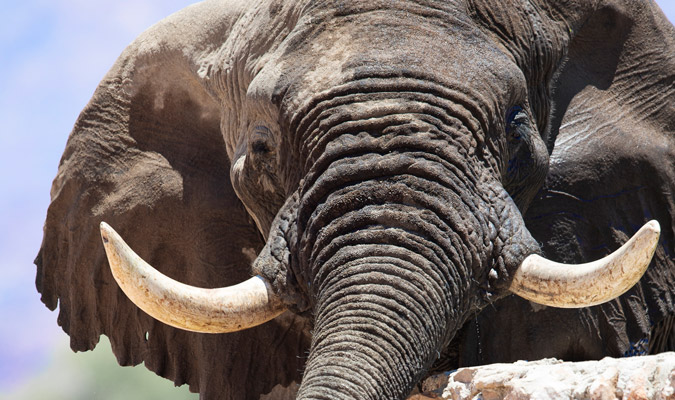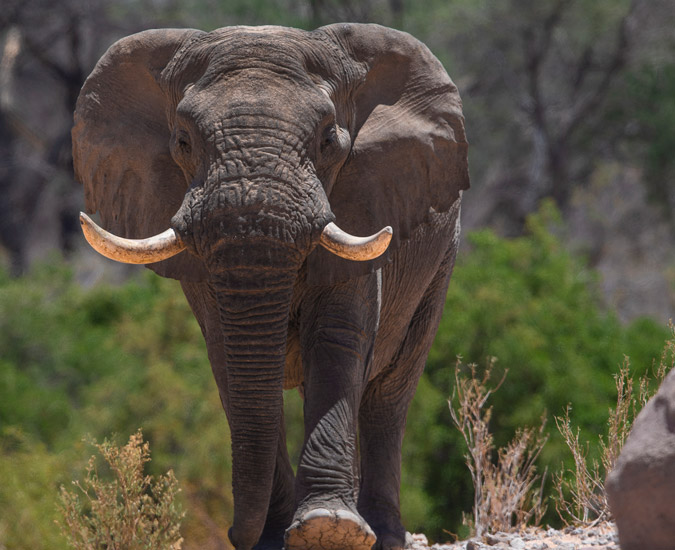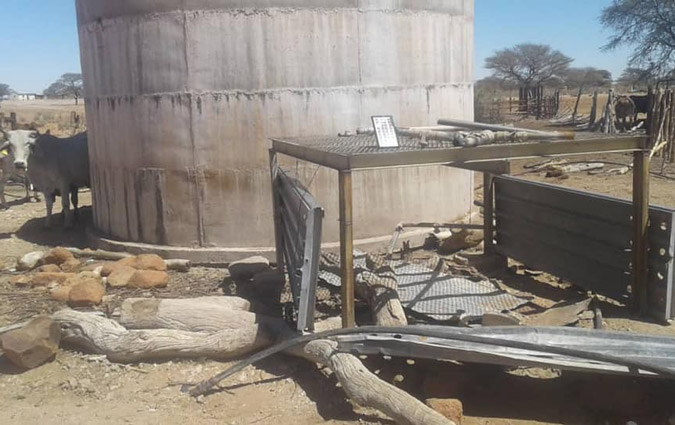
In yet another blow to big elephant genes, the iconic desert-adapted elephant bull known by millions of fans worldwide as ‘Voortrekker’ was killed by a trophy hunter after being declared a ‘problem animal by Namibian authorities. The surgical removal of Africa’s big-gene animals by trophy hunters continues, and Namibia’s desert-adapted elephants now rely on a small population of mature bulls after two were killed in 2016.
In their announcement on Facebook, Namibia’s Ministry of Environment and Tourism (MET) said “the elephant bull concerned was put down after it was declared a problem. The animal alongside others have been destroying properties and infrastructure in the area of Omatjete.” On the issue of whether this bull was the legendary Voortrekker, MET responded to Facebook questions by refusing to name the hunted elephant. Several conservation charities have confirmed that the bull in question is indeed Voortrekker. ‘Voortrekker’ is Afrikaans for ‘pioneer’.
MET spokesperson Romeo Muyunda Lee advised that the price paid was N$120,000 (+/- US$ 8,500), but it is unclear at this stage whether this was the total price paid or the portion paid to communities.
A study published in Ecology and Evolution in 2016 found not only that the Namibian desert-adapted elephants were different from their savannah cousins, but that their adaptations are also not genetically transferred to the next generation, rather through the passing on of knowledge by mature individuals. Morphological differences, like the adapted elephants’ thinner bodies and wider feet, also distinguish them from typical savannah elephants.

WAS THE WRONG ELEPHANT KILLED?
A Facebook post, written by Informante reporter Niël Terblanché, asks whether it was in fact Voortrekker who was causing problems for inhabitants of the Omatjete area.
Terblanché reports that an urgent letter addressed to MET official Christoph Munwela by the management of conservancies neighbouring the Ohungo Conservancy in the area of Omatjete to prevent the killing of Voortrekker, suggests that a flagrant error was made when the hunting license was issued. The letter points out that Voortrekker is in fact not part of the herd that has been bothering the community of the Ohungu Conservancy in the area of Omatjete.
MET responded publically that “The communities who objected to the hunt were not affected by the elephants as the elephants were mainly causing problems in the Omatjete area.”
Prior to the hunt, the management committees of the Otjimboyo, Sorris Sorris and Tsiseb conservancies asked Munwela for a meeting to discuss ways to avoid the killing of Voortrekker, one of the oldest living bull elephants in Namibia. Their letter said: “Our people are in general accepting of the elephants’ presence and want them to remain in the area … it is our belief that the shooting of elephants does not solve the problem. In fact, this only makes it worse. We want to keep our communities safe and to do this we need to ensure that our elephants are calm and relaxed when entering villages. It is our belief that the shooting of elephants or scaring them off with gunshots, screaming or chasing them off results in aggressive animals and this cannot be tolerated.”
ELEPHANT DAMAGE
MET published photographs that illustrate the damage caused to property and infrastructure by Voortrekker, to justify the issue of the hunting license. Some of the images appear to show poorly neglected fences and other infrastructure, but some easily-replaced water pipes and tanks do appear to reflect damage.

VOORTREKKER WAS PREVIOUSLY SAVED FROM TROPHY HUNTERS
In 2008 Voortrekker fans donated US$12 000 to MET in an effort to save him from professional hunters who had their eyes on his trophy tusks. At the time, six hunting permits were issued and only Voortrekker was saved from trophy hunter guns – the remaining five elephants were killed.
According to Johannes Haasbroek of Elephant Human Relations Aid, in the period since then, “the hunting outfitters and their sick clients conspired to get this gentle giant declared a problem to justify a hunt”. He went on to say: “We remember Voortrekker as an incredibly gentle, peaceful and magnificent elephant. His presence has often calmed other inexperienced elephants around him. He was known locally as the ‘Old Man’, which was always welcome because he never caused any problems or induced fear.”

VOORTREKKER’S STORY
According to respected safari guide Alan McSmith, Voortrekker was a pioneer elephant for the desert-adapted elephant population in the Ugab and Huab rivers region. This giant elephant was one of the first to venture back to the region after populations were decimated during the turbulent warfare years in southern Africa. A small group of these uniquely desert-adapted elephants took refuge during the war in the remote and desolate gorges of Kaokaland in the north.
Says McSmith: “Voortrekker, one of the bulls to trek north during the conflict years, returned home in the early 2000s, commencing a relay of south-bound expeditions, penetrating deeper and deeper into the dry and uncertain landscape before commencing with an epic traverse through to the relative bounty of the Ugab River. It was a marathon across arid plains and ancient craters that would ultimately redefine what we know of elephant endurance, intuition and behaviour. Just how he navigated or knew where to find water, is anyone’s guess. For over two successive summer seasons he returned north to Kaokaland, returning each time to the Ugab with a small family unit in tow. An elephant patriarch. These elephants are still resident in the region and have formed the nucleus of three distinct breeding herds, making the Ugab/Huab Rivers perhaps the most viable desert elephant habitats in the world. Voortrekker continues as the Godfather, a true legend of the Ugab. His ancestral knowledge has been passed down to a new generation of desert dwellers. What a legacy! For me, all of this addresses one of the most crucial fallacies of elephant conservation, trophy hunting, and the notion of sustainable consumption: that older bulls have no value to an elephant community and can be hunted under the banner of ecological benefit.”
To comment on this story: Login (or sign up) to our app here - it's a troll-free safe place 🙂.![]()






